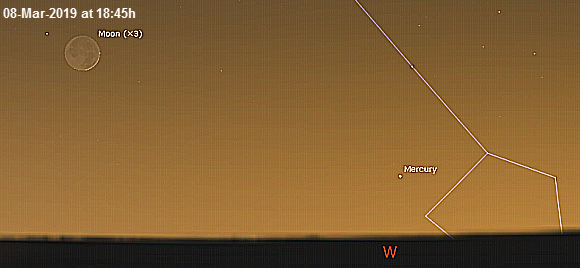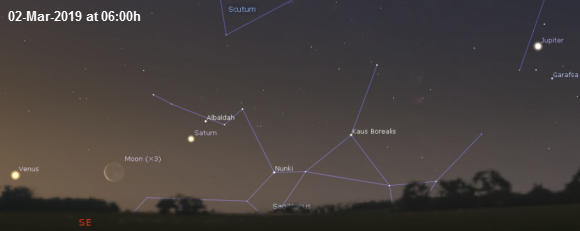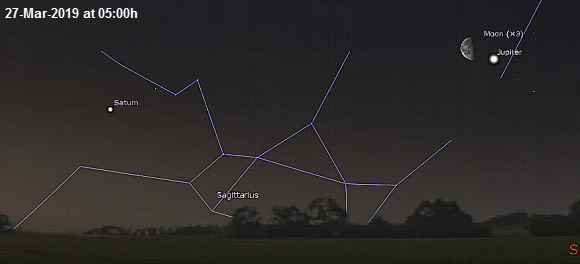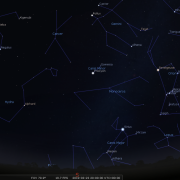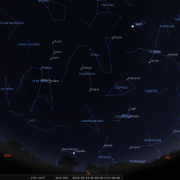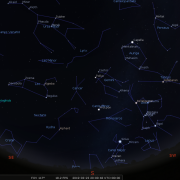
Welcome to the WDAS monthly newsletter for March 2019: a digest of the month's latest contributions to our website. Below you'll find Society News covering the Dark Matter Exhibition, a rare visit to the Bruce Observatory, and Sky Notes for the coming month.
Society News
 On March 1st we will be hosting an event at Fylinghall School, which is also being co-promoted by Baytown Coffee.
On March 1st we will be hosting an event at Fylinghall School, which is also being co-promoted by Baytown Coffee.
It’s 3 years since we last visited the School for a star night event, and it will be nice to renew ties. If conditions are satisfactory (not chucking it down, blowing a Hooley, or knee deep in snow- none of which look likely) the boarding students will be flogged enlisted to help out with a scaled solar system demonstration before observing is commenced, or the implementation of plan B (indoor presentation).
The location will be the front lawn of the School (facing the sea) starting around 19:20h. We shall therefore need to be present on site by 19:00h. Assistance with equipment transportation would be very welcome. We'll depart from Mark’s at 18:30h.
The event has been publicised in the Whitby Gazette, but further details can be found by contacting Angelique on marketing![]() fylinghall.org.
fylinghall.org.
 On Saturday March 2nd we will be in action again at the Danby Moors Centre for their Dark Sky half term event.
On Saturday March 2nd we will be in action again at the Danby Moors Centre for their Dark Sky half term event.
This is their ‘flagship event’, and if skies are clear we shall definitely require assistance from members regarding scopes/transport, similar to the event held last October.
Hopefully skies will be clear this time round, if so, we shall be observing some of the jewels of the winter sky. The event runs from 19:00h-21:00hpm, so we shall have to set off shortly after 6pm to allow time to set up equipment etc if conditions look promising.
These National Park events for the North Yorkshire area have been highlighted in the Astronomy Now Magazine extensively across the area, so it is likely to be sold out (If previous star party nights are anything to go by) with around 60-80 people present.
Although still a week away as this is written, the weather does look quite promising, so i hope it will be a good evening. We shall be meeting at Mark’s around for 17:55h.
The exhibition has now opened and is most definitely worth a visit. Sponsored by the Royal Society, the exhibition showcases the area’s connections investigating the cosmos, from Captain Cook’s 1768 voyage observing the transit of Venus to the search for Dark Matter at Boulby Underground Laboratory. The exhibition runs until early July.
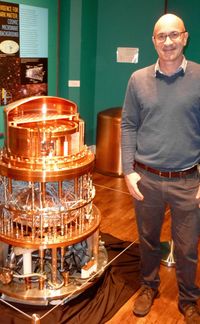 Mark and Phil were fortunate enough to be present at the opening night. After drinks and delicious nibbles, the exhibition was formally opened, before we were invited to preview the exhibition itself. This is first class, very professional looking, with some fantastic exhibits and plenty of explanatory text and picture boards to peruse at leisure.
Mark and Phil were fortunate enough to be present at the opening night. After drinks and delicious nibbles, the exhibition was formally opened, before we were invited to preview the exhibition itself. This is first class, very professional looking, with some fantastic exhibits and plenty of explanatory text and picture boards to peruse at leisure.
The undoubted star of the show (apart from the societies corner ) is the Zeplin 3 detector, which has been donated by the Dark Matter research team, and has been cut away to reveal the inner workings – all polished copper, photo couplers, and leads – it looks more like a work of art than a device to detect WIMPS from outer space! And to think the whole lot was entombed in lead.
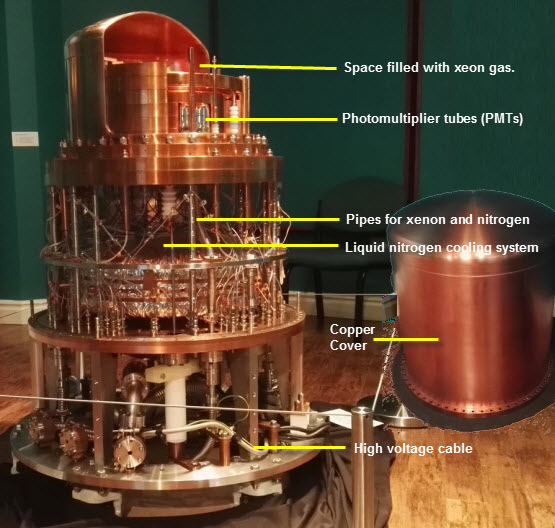
The Zeplin III's job is to detect the weak nuclear force by converting it into electrical charge
and light.When a WIMP collides with a nucleus of xenon it exerts a weak nuclear force. This collision
produces a tiny elecdtrical charge (in a process called ionisation) and a photon (in a process called
scintillation). Other particles also cause these effects, but measuring the ratio between the ionisation
and scintillation gives a definititve indication of whether a WIMP (hence dark matter) has been found.
A lecture was then given in the Normanby room by Professor Henrique Araujo of Imperial College London. “The Search for Dark Matter”, highlighted the internationally important work carried out at Boulby Underground Laboratory, and how the expertise of the various researchers is helping other Dark Matter labs in their research.
Although for the time being, the hunt for WIMPS has now ceased at the Boulby facility, it is nevertheless continuing on at pace in numerous other sites across the globe, in particular at the Sanford Underground Research Facility (SURF) in the Homestake mine – Lead, South Dakota.
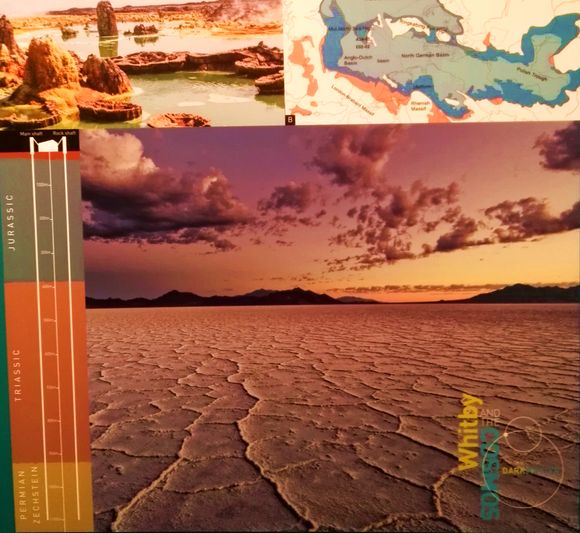

Top: 256-300m years ago, Boulby was close to the Zechstein Sea in the super-continent of Pangea.
N. Europe lay in the tropical belt and the sea went through repeated cycles of evaporation and flooding.
Bottom: Rocks mined at Boulby: Sylvinite/Potash (left); Halite/Rock salt (middle); Polyhalite (right).
Like Boulby, this is around a mile underground. Unlike Boulby, which after the 2009 economic crash, couldn’t secure funding for a Zeplin upgrade ie more liquid xenon (research always the first to suffer in the UK) Sanford seems to have had no such problem and have married together ideas and concepts used in Zeplin with their own.
Work on building the equipment for an experiment called LUX–ZEPLIN has already commenced, which according to Prof Araujo will try to detect particles of dark matter as soon as 2020. It seems the key in detecting WIMPS is much greater sensitivity of equipment, which also means larger quantities of liquid xenon, and that means deeper pockets.
So, the hunt goes on, but hopefully in the next 3 or 4 years the detection of WIMPS will verify that dark matter is real, and that the greater than expected rotational speed of spiral galaxies is not the work of some ‘unseen hand’.
Mark had a bit of a surprise at the event, more precisely, with someone who was present. More of which at our March meeting, suffice to say it’s a strange, small, world sometimes.
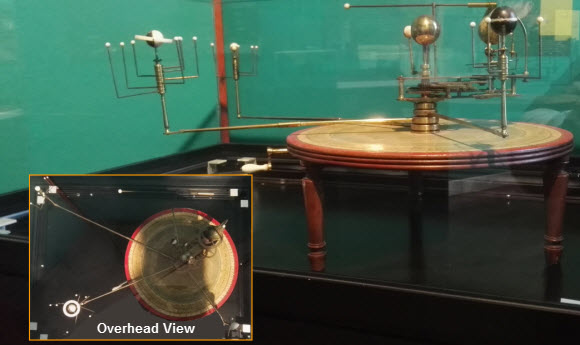
An Orrery (made between 1814 and 1839) at the Dark Matter Exhibition: a working model of
the Solar System showing the relative movements of the sun, planets and their moons.
 Our association with Ayresome Primary School & Lego Innovation Studio will be continued again this year after been contacted by Elizabeth Labelle; assistant Head Teacher (phase3).
Our association with Ayresome Primary School & Lego Innovation Studio will be continued again this year after been contacted by Elizabeth Labelle; assistant Head Teacher (phase3).
This year’s group of pupils (around 30 or so) will be stopping at the Whitby Youth Hostel from April 8th - 12th and we shall be hosting a star party event for them on either the 9th, 10th, or 11th, whichever evening according to the forecast looks best. We have hosted these events for the last three years, and Libby always says how much the pupils get from the event.
Start time will be around 20:15h on the Abbey Visitor Centre grass forecourt area.
After receiving a most intriguing email from Mr Jim Storey, concerning a Mr Norman Wright, who was keen on visiting the Bruce Observatory, it was arranged to meet up with Jim and Norman at the observatory on February 17th.
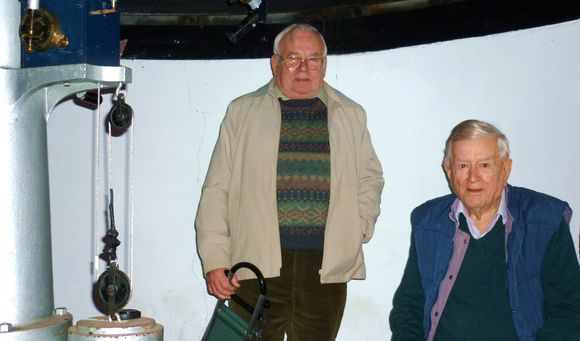
Jim Storey (left) and Norman Wright (right) at the Bruce Observatory
Fortunately it was a fine evening, with a gibbous moon visible. Norman, who is 91 and is a Bruce family relative, had never been in the Observatory before, or knew too much about it. He is keen however to see that it does not fall into disrepair (more on this next month).
Although unable to look through the telescope satisfactory, Norman nevertheless appeared to thoroughly enjoy his visit, and hear an account of its history (at least the parts we know of) as well as the restorative work and subsequent use by society members.
A brief word regarding society monthly meetings. It is very encouraging to see quite a few new (and some familiar) faces at the meetings (17 last month) If any members have something to share or are willing to give a presentation or talk related to astronomy, please contact Mark.
Sky Notes
In this month's Sky Notes:
- Planetary Skylights
- Meteors
- Spring Equinox
- February 2019 Sky Charts
Planetary Skylights
Evening Planets
 You can still glimpse Mercury in the evening twilight sky for the first week of March before it drops back toward the west horizon and is lost in solar glare. On March 2nd it reaches its greatest height above the horizon – around 9 degrees and at magnitude +0.9 should be pretty easy to spot with the naked eye. View between 18:15 to 18:45h (260 degree bearing) Use binoculars if you cannot spot it. A clear unobstructed aspect will be required. Mercury will rapidly diminish in brightness after the 5th, dropping back down. A very young crescent moon lies upper left on the 8th, but by the 10th Mercury is lost in twilight.
You can still glimpse Mercury in the evening twilight sky for the first week of March before it drops back toward the west horizon and is lost in solar glare. On March 2nd it reaches its greatest height above the horizon – around 9 degrees and at magnitude +0.9 should be pretty easy to spot with the naked eye. View between 18:15 to 18:45h (260 degree bearing) Use binoculars if you cannot spot it. A clear unobstructed aspect will be required. Mercury will rapidly diminish in brightness after the 5th, dropping back down. A very young crescent moon lies upper left on the 8th, but by the 10th Mercury is lost in twilight.
 Mars spends the first half of March moving up through Aries, crossing into Taurus later in the month and heading toward the Pleiades star cluster (M45) which it passes as March turns to April, lying 3 degrees to the east of the cluster. The Martian disk is now very small and most amateur scopes will struggle to reveal anything but the gibbous phase. The moon lies lower left on the 11th.
Mars spends the first half of March moving up through Aries, crossing into Taurus later in the month and heading toward the Pleiades star cluster (M45) which it passes as March turns to April, lying 3 degrees to the east of the cluster. The Martian disk is now very small and most amateur scopes will struggle to reveal anything but the gibbous phase. The moon lies lower left on the 11th.
Dawn Planets
And now for the Dawn Sky.
 In the dawn sky Venus hugs the SE horizon, becoming increasingly difficult to spot as we head into the latter third of the month. Only its brilliance saves it from being swamped by dawn twilight. The crescent moon sits between it and Saturn on the 2nd around 06:15h.
In the dawn sky Venus hugs the SE horizon, becoming increasingly difficult to spot as we head into the latter third of the month. Only its brilliance saves it from being swamped by dawn twilight. The crescent moon sits between it and Saturn on the 2nd around 06:15h.
 Saturn starts the month almost due SE, a few degrees above the horizon viewing around 06:00h. By the end of March it has moved a little further round to the south and gained a few degrees in altitude (viewing now at 06:00h). Because Saturn resides in Sagittarius all year, it’s always going to be pretty low to the horizon, and observations are going to be somewhat compromised due to our atmosphere. Nevertheless if you have a telescope your patience at the eyepiece will ultimately be rewarded, a glimpse of the ring system is not a site forgotten in a hurry. A slim waning crescent moon lies off to the right on the first morning of March and just below Saturn on 29th.
Saturn starts the month almost due SE, a few degrees above the horizon viewing around 06:00h. By the end of March it has moved a little further round to the south and gained a few degrees in altitude (viewing now at 06:00h). Because Saturn resides in Sagittarius all year, it’s always going to be pretty low to the horizon, and observations are going to be somewhat compromised due to our atmosphere. Nevertheless if you have a telescope your patience at the eyepiece will ultimately be rewarded, a glimpse of the ring system is not a site forgotten in a hurry. A slim waning crescent moon lies off to the right on the first morning of March and just below Saturn on 29th.
 Jupiter starts to dominate the dawn sky residing to the south as skies brighten. View around 06:00h at the start of the month and before 05:00h toward the end. By then Jupiter’s magnitude has increased to -2.3, with a disc size of almost 40 arc seconds, big enough for plenty of detail in the atmosphere to be observed. By the end of the month Jupiter is above the southeast horizon by 02:00h. If you view on the 27th, Jupiter is just over a degree from the rising waning crescent moon, a great photographic opportunity.
Jupiter starts to dominate the dawn sky residing to the south as skies brighten. View around 06:00h at the start of the month and before 05:00h toward the end. By then Jupiter’s magnitude has increased to -2.3, with a disc size of almost 40 arc seconds, big enough for plenty of detail in the atmosphere to be observed. By the end of the month Jupiter is above the southeast horizon by 02:00h. If you view on the 27th, Jupiter is just over a degree from the rising waning crescent moon, a great photographic opportunity.
Dates of interest for Galilean moon events are
- 3rd: Io shadow transit 06:00h
- 11th: Europa shadow transit 04:00h: and both Io and Ganymede start transits around 05:04h.
- 18th: Ganymede shadow starts transit 04:00h: and on the
- 19th: Io starts shadow transit 03:40h and Io itself from 05:00h.
The great red spot transits the disk on the following dates. 3/4th; 8/9th; 13-16th; 25/26th 03:00-05:00h.
Meteors

No major showers this month. However at the very end of March you may spot a few Virginids, which are slow moving and have long paths. As usual early morning hours are best to spot any meteors.
Spring Equinox
The date of the Vernal Equinox and of astronomical spring in the northern hemisphere (the official start of spring) falls on March 20th this year. This is when the Sun's path - the ecliptic, first crosses the celestial equator on its apparent journey northwards into the sky. The orientation of the Earth at the spring or autumnal equinox is such that neither of Earth’s poles are inclined toward the Sun and all locations experience equal hours of daylight and darkness - hence the term equinox.
The Vernal Equinox is also known as the 'First point of Aries', as the Sun used to stand before the constellation of the Ram when it first crossed the celestial equator. Although still called the 'first point of Aries', today its location now resides in Pisces, a consequence of the effect known as precession - the Earth's slow wobble Over thousands of years our ancestors noted that certain star patterns rose just before the Sun at specific times and were considered significant for this very reason. Subsequently they were able to build a picture of the apparent path of the Sun against these constellations.
The narrow path upon which occasionally the Sun and Moon would meet giving rise to an eclipse, became known as the Ecliptic. The broader belt along which the 'wandering stars' or planets travelled was known as the Zodiac, so called because all 12 constellations located on it were associated with living creatures.
Zodiac literally means 'Band of Animals'. Libra used to be considered being part of Scopius, the claws to be precise. Ophiuchus, the serpent bearer immediately following Scorpius was instead regarded as a zodiac group. Ever since the stars of Libra were elevated in status, Ophiuchus, being surplus to requirements, was ditched, much to the relief of astrologers. If you find it difficult to remember the order of the zodiac constellations, then the following rhyme may be of use.
The Ram, the Bull, the Heavenly twins and next the Crab the Lion shines, the Virgin, and the Scales. Scorpion, Archer and Sea goat, the man who pours the water out and Fish with glittering tails
March 2019 Sky Charts
|
Looking North
Latish March - 20:00h |
Looking South |
|
Looking East
Latish March - 20:00h |
Looking West
Latish March - 20:00h |
|
Northern Aspect
Latish March - 20:00h |
Southern Aspect
Latish March - 20:00h |
| Looking North (Early) Mid-March - 05:00h |
Looking South (Early) Mid-March - 05:00h |
Additional Image Credits:
- Planets and Comets where not otherwise mentioned: NASA
- Sky Charts: Stellarium Software

The date of the Vernal Equinox and of astronomical spring in the northern hemisphere (the official start of spring) falls on March 20th this year. This is when the Sun's path (‘the ecliptic’) first crosses the celestial equator on its apparent journey northwards into the sky. The orientation of the Earth at the spring or autumnal equinox is such that neither of Earth’s poles are inclined toward the Sun and all locations experience equal hours of daylight and darkness; hence the term equinox.
 The Vernal Equinox is also known as the 'First point of Aries', as the Sun used to stand before the constellation of the Ram when it first crossed the celestial equator. Although still called the 'first point of Aries', today its location now resides in Pisces, a consequence of the effect known as precession - the Earth's slow wobble Over thousands of years our ancestors noted that certain star patterns rose just before the Sun at specific times and were considered significant for this very reason. Subsequently they were able to build a picture of the apparent path of the Sun against these constellations.
The Vernal Equinox is also known as the 'First point of Aries', as the Sun used to stand before the constellation of the Ram when it first crossed the celestial equator. Although still called the 'first point of Aries', today its location now resides in Pisces, a consequence of the effect known as precession - the Earth's slow wobble Over thousands of years our ancestors noted that certain star patterns rose just before the Sun at specific times and were considered significant for this very reason. Subsequently they were able to build a picture of the apparent path of the Sun against these constellations.
The narrow path upon which occasionally the Sun and Moon would meet giving rise to an eclipse, became known as the Ecliptic. The broader belt along which the 'wandering stars' or planets travelled was known as the Zodiac, so called because all 12 constellations located on it were associated with living creatures.
Zodiac literally means 'Band of Animals'. Libra used to be considered being part of Scopius, the claws to be precise. Ophiuchus, the serpent bearer immediately following Scorpius was instead regarded as a zodiac group. Ever since the stars of Libra were elevated in status, Ophiuchus, being surplus to requirements, was ditched, much to the relief of astrologers. If you find it difficult to remember the order of the zodiac constellations, then the following rhyme may be of use.
The Ram, the Bull, the Heavenly twins
and next the Crab the Lion shines,
The Virgin, and the Scales.
Scorpion, Archer and Sea goat,
the man who pours the water out
and Fish with glittering tails.


